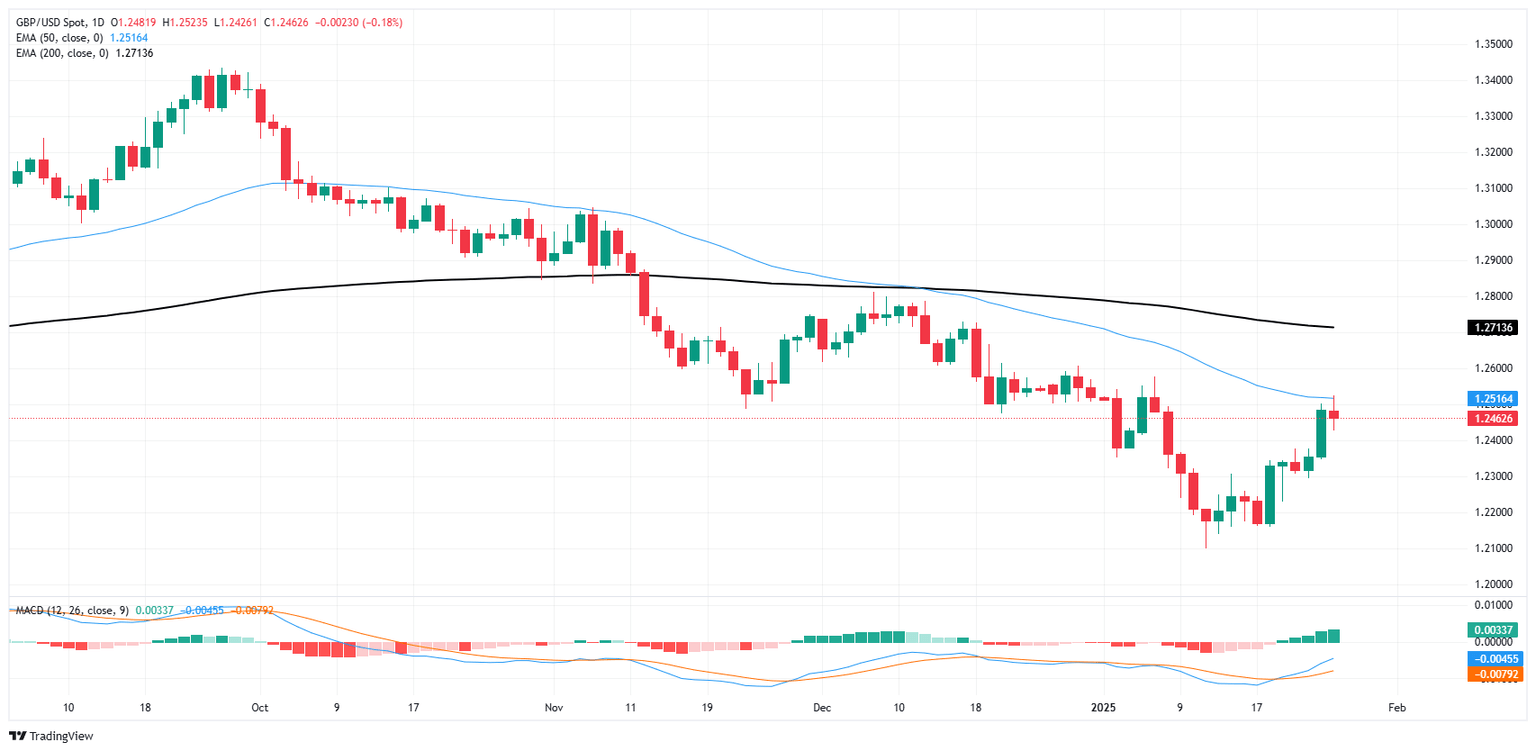GBP/USD continues to struggle near key levels
- GBP/USD dropped a doji candle on Monday as Cable middles.
- UK data remains limited this week, and markets focus on the Fed.
- Technical signs of exhaustion could spell the end of the Pound rally.

GBP/USD got hung up on key technical levels for the second trading day in a row, dropping a spinning top candle near the 1.2500 handle and leaving Cable traders facing a bearish downturn depending on how the Federal Reserve’s (Fed) rate call goes later this week.
UK data is extremely limited this week, leaving Cable bidders to face Wednesday’s upcoming Fed rate call entirely alone. The Fed is broadly expected to stand pat on interest rates for January, and depending on how confident the Fed’s Chair Jerome Powell sounds during his mid-week press conference, market hopes of an uptick in the pace of Fed rate cuts in 2025 could get thrown in jeopardy. Markets have stepped up their expectations of Fed rate cuts through the year, doubling the pace of rate cuts through the calendar year to 50 bps in total.
Political headlines are again gripping markets after US President Donald Trump got into a social media spat with Colombia as the two countries battled over the travel conditions of migrants from Colombia being extradited from the US, culminating in Donald Trump threatening massive tariffs of 50% on all US-bound exports from Colombia. The tariff through ultimately turned out to be all bluster, no bite, but countries and markets are taking notice of how quickly Trump-imposed tariffs can come out of the woodwork.
GBP/USD price forecast
A spinning top candlestick pattern bodes poorly for Cable bulls, with GBP/USD continuing to get hung up on the 1.2500 price handle. The pair has run aground of further technical resistance from the 50-day Exponential Moving Average (EMA) descending into 1.2500, and bullish momentum that has given the pair a leg up appears to be draining out of the charts.
GBP/USD daily chart

Pound Sterling FAQs
The Pound Sterling (GBP) is the oldest currency in the world (886 AD) and the official currency of the United Kingdom. It is the fourth most traded unit for foreign exchange (FX) in the world, accounting for 12% of all transactions, averaging $630 billion a day, according to 2022 data. Its key trading pairs are GBP/USD, also known as ‘Cable’, which accounts for 11% of FX, GBP/JPY, or the ‘Dragon’ as it is known by traders (3%), and EUR/GBP (2%). The Pound Sterling is issued by the Bank of England (BoE).
The single most important factor influencing the value of the Pound Sterling is monetary policy decided by the Bank of England. The BoE bases its decisions on whether it has achieved its primary goal of “price stability” – a steady inflation rate of around 2%. Its primary tool for achieving this is the adjustment of interest rates. When inflation is too high, the BoE will try to rein it in by raising interest rates, making it more expensive for people and businesses to access credit. This is generally positive for GBP, as higher interest rates make the UK a more attractive place for global investors to park their money. When inflation falls too low it is a sign economic growth is slowing. In this scenario, the BoE will consider lowering interest rates to cheapen credit so businesses will borrow more to invest in growth-generating projects.
Data releases gauge the health of the economy and can impact the value of the Pound Sterling. Indicators such as GDP, Manufacturing and Services PMIs, and employment can all influence the direction of the GBP. A strong economy is good for Sterling. Not only does it attract more foreign investment but it may encourage the BoE to put up interest rates, which will directly strengthen GBP. Otherwise, if economic data is weak, the Pound Sterling is likely to fall.
Another significant data release for the Pound Sterling is the Trade Balance. This indicator measures the difference between what a country earns from its exports and what it spends on imports over a given period. If a country produces highly sought-after exports, its currency will benefit purely from the extra demand created from foreign buyers seeking to purchase these goods. Therefore, a positive net Trade Balance strengthens a currency and vice versa for a negative balance.
Author

Joshua Gibson
FXStreet
Joshua joins the FXStreet team as an Economics and Finance double major from Vancouver Island University with twelve years' experience as an independent trader focusing on technical analysis.

















